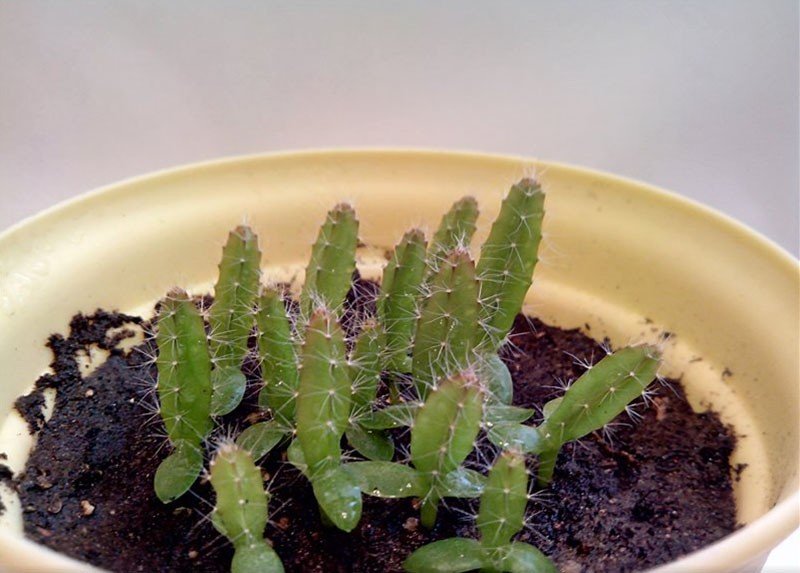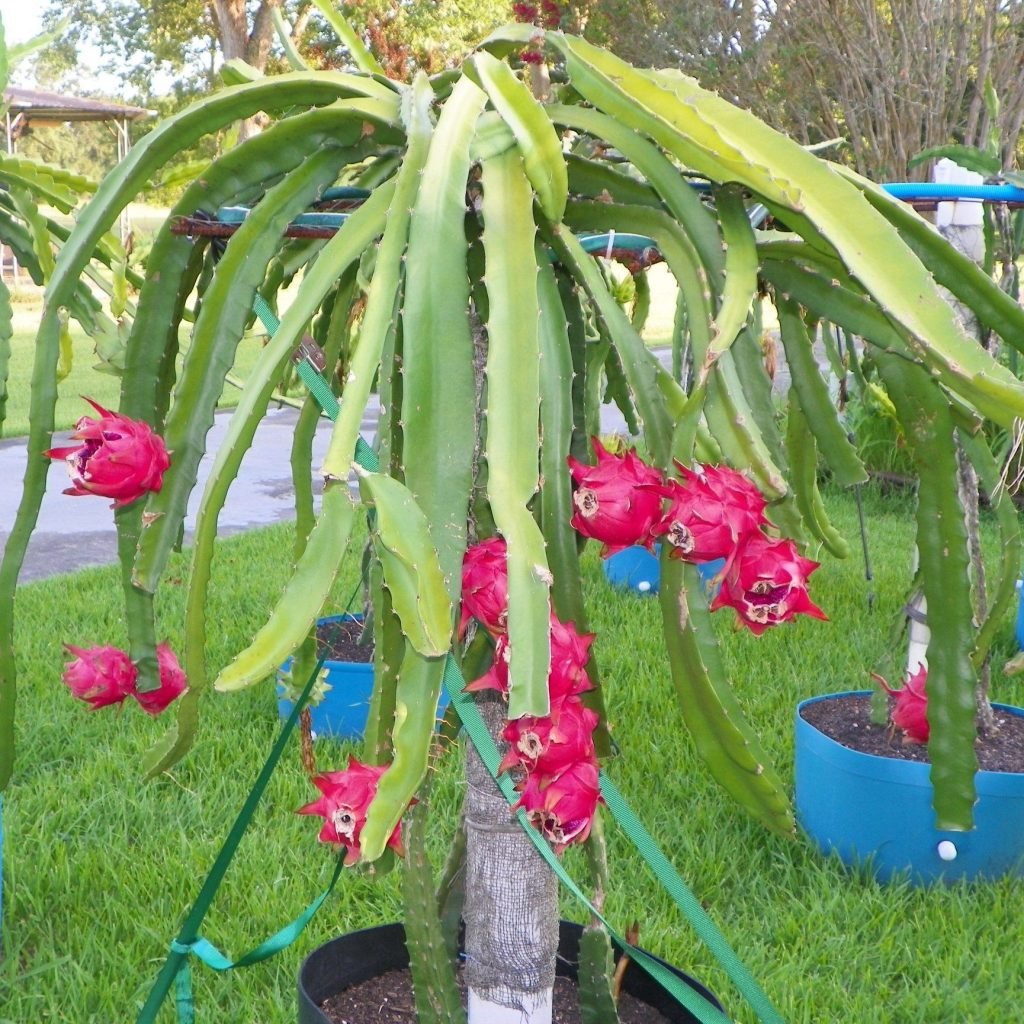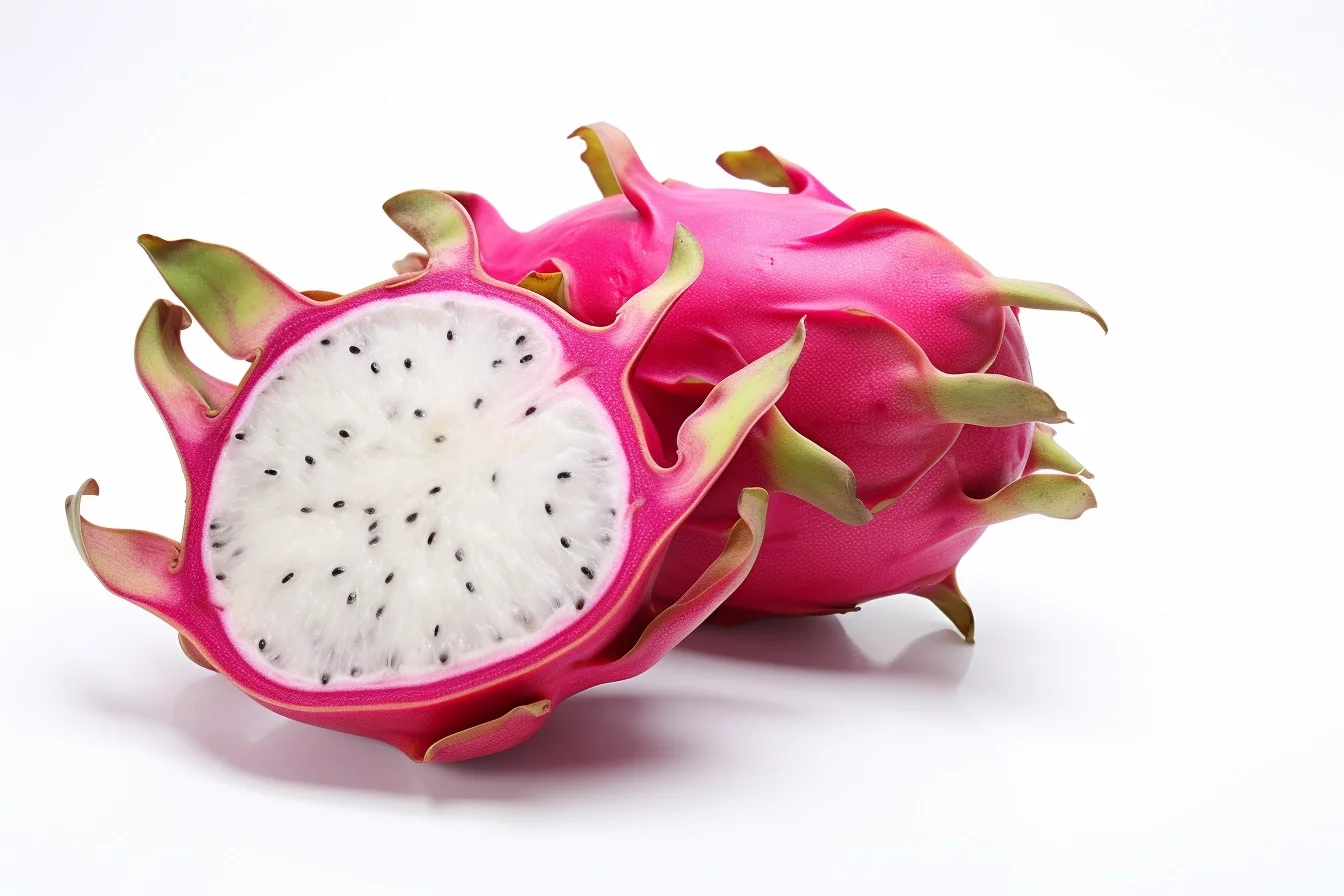Dragon Fruit (Hylocereus undatus) Overview
As a seasoned gardener and journalist who’s delved deeply into the world of indoor plants, I’ve developed a particular fondness for the Dragon Fruit Cactus, or Pitaya. This plant, known botanically as Hylocereus undatus, has not only graced my living space with its unique aesthetics but has also intrigued me with its blend of ease of care and exotic fruit production. Let me guide you through why choosing a Dragon Fruit Cactus as a houseplant is a rewarding decision, backed by botanical insights and popular varieties.

Why Choose a Dragon Fruit Cactus as a House Plant
Aesthetic Appeal and Practical Benefits
The Dragon Fruit Cactus stands out with its sprawling, sculptural beauty. Its long, winding stems and vibrant flowers offer an eye-catching display that can transform any indoor space. Beyond its visual appeal, growing a Dragon Fruit Cactus indoors can be incredibly gratifying, especially when it bears its delicious and nutritious fruit. The experience of nurturing it from a mere cutting to a fruit-bearing plant is nothing short of magical.
Ease of Care
One of the reasons I advocate for the Dragon Fruit Cactus as a houseplant is its relative ease of care. It’s a resilient plant that forgives occasional lapses in watering and can thrive in various light conditions. For busy plant lovers or beginners, this makes the Dragon Fruit Cactus an ideal choice.
Health and Air-Purifying Qualities
Like many houseplants, the Dragon Fruit Cactus contributes to a healthier indoor environment. It’s known for its air-purifying qualities, making it not just a decorative element but also a beneficial companion in your living space.
Botanical Information
Understanding the Hylocereus Undatus
The Dragon Fruit Cactus belongs to the genus Hylocereus, which is part of the Cactaceae (cactus) family. It’s a tropical cactus, which differentiates it from the desert cacti most are familiar with. Native to Central and South America, it thrives in warm, humid conditions.
Growth Habits and Characteristics
This cactus is known for its climbing or sprawling habit, often requiring support as it grows. The stems are ribbed and can develop aerial roots that help it cling to supports. Its flowers are large and nocturnal, often blooming for just one night. The fruit, known as dragon fruit or pitaya, is oval, with a vibrant pink or yellow exterior and a seeded, sweet pulp inside.
Dragon Fruit Cactus Popular Varieties
Hylocereus Undatus (White-Fleshed Pitaya)
The most commonly known variety, it produces white-fleshed fruit with a mild, sweet taste. It’s recognized for its night-blooming, large white flowers and is often the variety people start with when growing dragon fruit indoors.
Hylocereus Costaricensis (Red-Fleshed Pitaya)
This variety, also known as Costa Rican pitaya, is prized for its deep red-fleshed fruit, offering a slightly sweeter flavor than the white-fleshed variety. It adds a striking pop of color to any indoor garden.
Hylocereus Megalanthus (Yellow Pitaya)
Not as common but equally fascinating, this variety produces yellow-skinned fruit with white flesh. It’s known for its sweeter and juicier fruit compared to its red and white counterparts.
In my journey as a home gardener, the Dragon Fruit Cactus has been a standout for its intriguing growth habits and, stunning floral displays.
Indoor Dragon Fruit Plant (Pitaya) Care Guide
Light: The Lifeline of Pitaya 🌞
Optimal Lighting Conditions
Dragon Fruit Cacti thrive in bright light. When grown indoors, place your Pitaya plant near a south-facing window where it can bask in the sun for at least 6-8 hours a day. This plant loves sunlight, and ample light is crucial for its growth and fruiting.
Adapting to Indoor Lighting
If natural light is limited in your space, consider using grow lights. LED grow lights that emit full-spectrum light can be particularly effective. Position the light about 6-12 inches above the plant and keep it on for about 12-14 hours a day to mimic natural sunlight conditions.
Water: Balancing Moisture and Drainage 💧
Watering Your Pitaya
Dragon Fruit Cacti, like most cacti, prefer less water than other tropical plants. The key is to let the soil dry out between watering. Overwatering can lead to root rot, so it’s essential to water only when the top inch of the soil feels dry to the touch.
Techniques for Proper Watering
Use a watering can with a long spout to target the soil directly, avoiding water on the stems or leaves. During the winter months, reduce watering frequency as the plant enters a dormant phase.
Soil: Foundation for Healthy Growth 🌱
Choosing the Right Soil Mix
For Pitaya plants, well-draining soil is non-negotiable. A mix of potting soil, coarse sand, and perlite or pumice in equal parts works well. This combination ensures good drainage and aeration, key to preventing waterlogged roots.
Repotting Considerations
Repotting every 2-3 years or when the plant outgrows its pot is recommended. Always choose a pot with drainage holes to prevent excess water accumulation.
Temperature and Humidity: Creating the Ideal Environment 🌡️💦
Ideal Temperature Range
Dragon Fruit Cacti prefer warm temperatures, ideally between 65°F to 85°F (18°C to 29°C). They can tolerate higher temperatures, but growth may slow down if it gets too hot.
Managing Humidity Levels
These cacti do well in moderate humidity. If your home is particularly dry, especially in winter, using a humidifier can help. However, avoid creating a highly humid environment as this can promote fungal diseases.
Fertilizer: Nutritional Support for Your Pitaya 🍲
Fertilizing Your Dragon Fruit Cactus
Feed your Pitaya with a balanced, water-soluble fertilizer during the growing season (spring and summer). A formula designed for cacti and succulents, diluted to half strength, is ideal. This provides the necessary nutrients without the risk of over-fertilization.
Frequency of Fertilization
Fertilize once a month during the growing season. In the dormant period (fall and winter), reduce or stop fertilizing as the plant’s growth slows down.
Signs of Over or Under-Fertilization
If your Pitaya shows signs of weak growth or the leaves turn yellow, it might need more nutrients. Conversely, brown leaf tips or a crust of fertilizer on the soil surface can indicate over-fertilization. Adjust your fertilizing routine accordingly.
Caring for a Dragon Fruit Cactus indoors requires understanding and balancing its unique needs. By providing the right light, water, soil, temperature, and humidity, you create an environment where your Pitaya can not only grow but potentially fruit. Regular fertilization, tailored to its growth cycle, further ensures your Dragon Fruit Cactus remains healthy and vibrant.

Indoor Dragon Fruit Cactus Crowing Guide
Now we’ll explore the nuances of propagating, potting, and pruning this fascinating plant, drawing from the best practices.
How to Propagate
Starting from Seeds
Propagation of Dragon Fruit Cactus can begin with seeds, though it’s a slower process. To start, extract seeds from a ripe dragon fruit. Clean and dry them before sowing them in a well-draining soil mix. Keep the soil consistently moist and in a warm, bright spot. Patience is key here, as seedlings can take several weeks to appear.
Propagating from Cuttings
A more common and quicker method is propagation from stem cuttings. Select a healthy stem segment about 6-8 inches long. Allow the cut end to dry and callous over for a few days. Then, plant the cutting in a mix of potting soil and perlite, ensuring that it stands upright. Water sparingly until roots develop, which typically takes a few weeks. This method is particularly effective for ensuring a clone of the parent plant in terms of fruit quality.
Potting and Repotting
Choosing the Right Container
When potting your Dragon Fruit Cactus, select a container that’s slightly larger than the root ball. It’s vital to use a pot with good drainage to prevent waterlogged soil, which can lead to root rot.
Soil Requirements
The ideal soil for Pitaya offers excellent drainage. A mix of regular potting soil with sand and perlite or orchid bark works well. This ensures that excess water drains quickly, while still retaining enough moisture for root uptake.
When to Repot
Repotting is typically necessary every 2-3 years or when the plant outgrows its container. The best time to repot is in the spring or early summer. When repotting, gently remove the plant, trim any dead roots, and place it in the new pot with fresh soil. Water it thoroughly after repotting to help settle the soil around the roots.
Pruning
Why Prune Your Dragon Fruit Cactus
Pruning is essential for maintaining the health and appearance of your Pitaya. It helps in shaping the plant, encouraging more branching, and can stimulate flowering and fruiting. Pruning also allows you to remove any dead or diseased parts of the plant.
Pruning Technique
Use clean, sharp pruning shears. Make cuts near a branching point or a node. If you’re pruning to encourage branching, cut the stem at the height where you want new growth to appear. Be cautious not to over-prune, as this can stress the plant.
Aftercare
After pruning, avoid watering your plant for a few days to allow the cuts to heal. This prevents any potential fungal infections at the pruning sites.
Addressing Pests and Plant Diseases
In this section, we’ll explore the common issues that may arise and how to effectively combat them, ensuring your Pitaya remains healthy and vibrant.
Pests: The Unwanted Guests
Identifying Common Pests
Spider Mites and Mealybugs are two of the most common pests you might encounter with your indoor Pitaya plant. Spider mites are tiny and often identified by the fine webbing they leave on the plant. Mealybugs, on the other hand, are visible as small, white, cottony masses on the stems or underside of leaves.
Strategies for Pest Control
- Regular Inspection: Consistently check your plant for any signs of pests. Early detection is key to preventing a full-blown infestation.
- Isolation: If you detect pests, isolate your Pitaya plant to prevent the spread to other houseplants.
- Natural Remedies: Introduce natural predators like ladybugs, or use neem oil, a natural pesticide, to combat these pests.
- Insecticidal Soaps: These can be effective in controlling pests, especially if applied regularly until the pests are eradicated.
Plant Diseases: Tackling Common Issues
Common Diseases in Dragon Fruit Cactus
- Root Rot: Often caused by overwatering, root rot is a major concern. It leads to a weakening and eventual decay of the root system.
- Fungal Diseases: These include issues like stem rot, which can occur in high humidity and poor air circulation conditions.
Prevention and Treatment
- Adequate Watering: Avoid overwatering and ensure your potting mix is well-draining. Water only when the topsoil is dry.
- Proper Air Circulation: Ensure your Pitaya plant is in a well-ventilated area to reduce the risk of fungal diseases.
- Fungicides: In cases where fungal diseases are detected, apply appropriate fungicides as per the instructions. However, prevention is always better than cure.
Common Problems and Their Solutions
Dealing with Drooping or Yellowing Leaves
- Cause: Often a sign of overwatering or poor drainage.
- Solution: Reduce your watering frequency and check if the potting mix is draining properly.
Slow Growth or Lack of Flowering
- Cause: This could be due to insufficient light or inadequate nutrients.
- Solution: Move your plant to a brighter location and consider applying a balanced, slow-release fertilizer during the growing season.
Brown Spots on Leaves
- Cause: This is often a sign of a pest infestation or a fungal infection.
- Solution: Inspect for pests and treat accordingly. Improve air circulation and reduce humidity if a fungal infection is suspected.

FAQ
Is Dragon Fruit a Cactus?
Yes, Pitaya, is a type of cactus. It’s part of the Cactaceae family and the Hylocereus genus. This plant is a climber and is known for its beautiful night-blooming flowers and tasty fruit. The fruit is usually pink or yellow and has small black seeds and sweet, pear-like flesh.
How Long Until a Dragon Fruit Cactus Bears Fruit Indoors?
Growing dragon fruit indoors requires patience. It can take about 3 to 5 years for an indoor Dragon Fruit Cactus to start fruiting. This depends on giving the plant enough sunlight, proper care, and the right conditions for growing and making fruit.
Should You Trim Dragon Fruit Cactus?
Yes, trimming or pruning your Dragon Fruit Cactus is important. It keeps the plant from getting too big, helps it grow more fruit, and lets air flow better around the plant. For climbing cacti like Hylocereus, it’s important to give support and trim back any stems that are too long for good health.
How to Care for Potted Dragon Fruit?
Caring for Dragon Fruit in pots involves a few important steps:
- Light: They need lots of sunlight, so place them where they’ll get several hours of direct sun each day.
- Water: Water only when the soil is dry. These cacti don’t need a lot of water.
- Soil: Use soil that drains well and is rich in organic stuff.
- Fertilizer: Occasionally use a fertilizer for cacti with low nitrogen.
How Often to Water and Should You Mist Dragon Fruit Cactus?
Water your Dragon Fruit Cactus only when the soil is dry. Too much water can harm the plant. Misting usually isn’t needed since these plants like dryer conditions. Water well, but not too often, to keep your cactus healthy.
How Long Does It Take for Dragon Fruit to Start Producing Fruit?
Growing dragon fruit can be a bit of a wait, but it’s worth it. Usually, it takes about 5 to 7 years for a dragon fruit plant to mature and start giving fruit. This seems long, but imagine the sweet, delicious fruit you’ll get at the end!
When Do Dragon Fruit Cacti Bloom?
Expect to see your dragon fruit cactus bloom in about 3 to 5 years after planting. The flowers are big and beautiful, opening up at night. After they bloom, the fruit takes about a month to get ripe and ready.
Is It Hard to Grow Dragon Fruit Indoors?
Not really! Dragon fruit plants are surprisingly easy to grow inside your home. They love sunny spots near windows and need well-draining soil. With some sunlight each day and the right soil, they can grow quite big.
How Can I Tell if I Have a Dragon Fruit Cactus?
A Dragon Fruit Cactus has some unique features. It has thick, fleshy stems that are usually three-sided. If it’s mature, you might see it bloom at night with really large flowers. There are different kinds of dragon fruit plants, but they all share these common traits.
Introduction
Nicki Mann, based in Portland, Oregon, is a good writer and houseplant enthusiast. With her background in environmental science, Nicki specializes in indoor gardening, focusing on sustainable and organic practices.
Experience
Her interest in houseplants began in her mid-twenties, leading to a career writing articles about indoor plant care and eco-friendly gardening for various websites.
Education
Nicki holds a Bachelor of Science in Environmental Studies from the University of Oregon, which underpins her approach to indoor gardening. She continually enhances her knowledge through horticulture and environmental sustainability workshops.
Personal Life
Nicki, an avid nature lover, enjoys exploring the Pacific Northwest's trails. She's active in community gardening and lives with her two rescue cats, who share her interest in her growing collection of houseplants.


